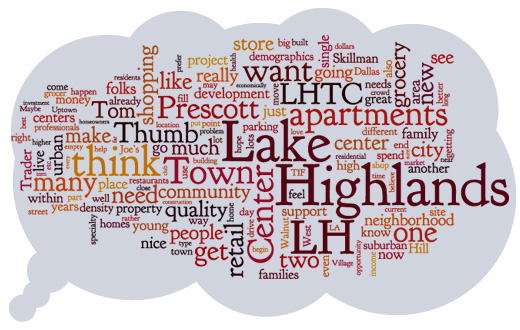All the talk of new stores and restaurants in Lake Highlands has left neighbors wondering what, if anything, we can do about the seeming retail shortage.
It’s an age-old question for neighborhood residents and a constant topic of conversation: Where’s the retail?
Dallas’ eclectic dining scene has put this city on the culinary map. So, where’s our piece of the pie?
Proud Lake Highlands residents simply can’t understand why an area with a strong sense of community, deep pocketbooks and a yearning to “live locally” can’t seem to attract — or keep — its shopping centers filled. Every day, aggravated and perplexed neighbors voice their frustrations on Advocate’s Back Talk blog:
“Our community longs for a place where we can spend our dollars in our own community and have the same type of quality of dining and shopping that those that live in Highland Park and in the West Village [have]. We have the small town feel, committed community, big dollars to spend and no one gives us the time of day. I understand the economy is struggling, but people have to eat, shop and live!” —Frustrated Wildcat
“My basic belief is that we have people on two ends of the spectrum — low income and high income — with the former generally in the old apartments and the latter generally in single-family homes. … [An] increase in density of middle-class or semi-affluent folks, including (and preferably) families, around the [Lake Highlands Town Center] property would be greatly beneficial to Lake Highlands and would help fill the retail gaps with quality retail/restaurants.” —LH Newbie
Most of our hopes are hanging on the Town Center, with predictions of 220,000 square feet of new retail and restaurant space. But the long wait for tenant announcements and construction at Skillman and Walnut Hill has left us perplexed about this intersection as well as corners all over our neighborhood.
Where are the retailers, the developers, the redevelopers and the restaurateurs?
Or better yet, how do we get them?
Get on our knees and beg?
In light of the recent “LH Hearts Trader Joe’s” movement, during which Lake Highlands residents gathered to create a petition drive, a promotional video and a “LHTC is the perfect place for Trader Joe’s” Facebook page, neighbors can’t help but wonder, will it work?
According to Ian Pierce, spokesman for brokerage company The Weitzman Group and its management arm, Cencor Realty Services, it can’t hurt. Weitzman and Cencor oversee leasing and management at area shopping centers, including the Kroger-anchored Northview Plaza at Plano and Northwest Highway.
“In examples I’ve seen, movements like that work to bring a retailer to the community in general,” Pierce says. “I personally think the rally showed that the community is active and interested, and the publicity it generated certainly can attract retailer attention.”
Jean Smith, COO/partner of United Commercial Realty, which represents Sprouts Farmers Market, has worked with Lake Highlands Town Center developer Prescott Realty Group and has met with the Lake Highlands Area Improvement Association numerous times. He believes that while these types of movements may not hurt, they also may not be the answer.
“These movements are helpful because they give exposure, but ultimately a tenant is going to go where it’s going to go,” Smith says. “There is a small percentage of tenants who are lured by community outreach.”
Unfortunately for neighbors who rallied for Trader Joe’s, the grocer’s spokeswoman Allison Mochizuki seems to agree:
“The area of Lake Highlands is not in our two-year plan at this time,” Mochizuki says. “Although it is very nice to be wanted, wooing doesn’t go into our decision making processes of selecting a location.”
Smith says retailers’ decisions rely mostly on research: housing data, density, growth, income and education.
“Lake Highlands has some major frontage on LBJ but no Highway 75 access, and that’s an issue for retailers,” Smith says. “The area also needs better, higher-income multi-family apartments.”
Rebecca Range, executive director of the Lake Highlands Public Improvement District, is trying to facilitate just that.
Tear down or upgrade the apartments?
The Lake Highlands Public Improvement District, established in 2008, is a conglomeration of mostly commercial and some multi-family properties along Skillman between Northwest Highway and LBJ. These property owners have agreed to pay an additional tax of sorts that is funneled into efforts to maintain and revitalize public areas, oversee public safety programs, and promote growth.
Range has been working diligently to tackle the run-down apartments in our area through city codes, while recognizing and promoting well-maintained and safe apartments and their owners.
“We are working on a program to incentivize good apartment property managers by offering grants or financial awards to those who reach Gold Star status,” Range says.
Gold Star status is reached through the Dallas Police Department’s certification program, which rates properties according to safety education, training, active crime prevention and a security survey of the property conducted by a Dallas police officer.
“For instance, if a complex reaches Gold Star status, we might reward them by building a library or a playground for them,” Range says.
City Council District 10, which encompasses most of Lake Highlands, has 24,000 multi-family homes — “half a billion dollars worth of apartments,” says Councilman Jerry Allen, who represents District 10. Expecting that many moneymaking units to be bulldozed isn’t realistic, he says. A scenario such as the Lake Highlands Town Center, when roughly 1,400 units were razed to make way for retail, residential and office construction, is an anomaly.
“The best you can hope for is tearing down maybe 3,000 units per economic cycle — every four to five years. That’s if you’re lucky.”
Because of the recession, funds for new development are scarce, Allen says. It’s the reason he, like Range, has focused more on “socially responsible apartments and providing after-school programs for the kids” for the last couple of years.
Improving local apartments will help, Range says, but that alone is not the key to more retail development. The answer, she says, is branding.
‘Brand’ our neighborhood?
“Developers think they don’t want to be in Lake Highlands because the external perception isn’t that great,” Range says. “Lake Highlands needs a better overall PR campaign; this is critical. But first, Lake Highlands needs to decide what it wants to be.”
Range believes that neighbors need to work better as a community to establish a strategic branding plan, one that will determine who we are and what we want.
“Does Lake Highlands want to target developers or redevelopers?” Range inquires. “Does it want to be known as a small, Norman Rockwell-esque town or a place that welcomes hip and trendy new businesses?”
That’s why upon receiving her post with the Lake Highlands Public Improvement District, Range organized a meeting between the heads of several neighborhood organizations to form a branding committee.
“If we don’t attack some of our underlying issues, we may never get anywhere with retail,” Range says.
Shop really local?
Lake Highlands resident and UCR Urban vice president David Shelton says it would be almost impossible to bring national fashion retail to Lake Highlands because NorthPark Center and other major fashion hubs are already located nearby. He believes, however, that our neighborhood is a great opportunity for restaurants and boutique retailers.
“These types of businesses would thrive here,” Shelton says.
Though demographics do matter, Shelton says, “at least 25 percent of what potential retailers look at when deciding on a location is how other similar businesses are doing. You can’t change demographics overnight, and incentivizing potential retailers helps, but only goes so far.”
In other words, shopping local isn’t just a gimmick that cities and chambers of commerce have adopted en masse. If Lake Highlanders want new retailers and restaurants to move into our neighborhood, “there is only one answer: We must support the restaurants and retail that are already in the market,” Shelton says. “No one wants to be a pioneer.”
—————————————————————–
Town Center by the demographics
If a retail revival is going to start anywhere in Lake Highlands, the Town Center at Walnut Hill and Skillman is the most likely starting point. That’s where the city’s office of economic development is concentrating its efforts, says Sue Hounsel, who works directly with the city’s tax incentive programs that effect the Skillman corridor.
But even the millions of tax dollars pumped into the Town Center from both the city and other government agencies can go only so far.
“The economic downturn has certainly made getting retail in Lake Highlands a challenge,” Hounsel says. “Retailers are looking for a certain number of rooftops with a certain income when it comes to specialty stores and gourmet grocers.”
If demographics matter to retailers, then it’s best to know how our neighborhood stacks up. How does Walnut Hill and Skillman compare to, say, Preston and Royal, where Central Market recently announced it would open a new store in the former Borders spot, which real estate types say Trader Joe’s had been eyeing? Or what about Mockingbird and Abrams, where decades-old Hillside Village on the northeast corner recently underwent changes that resulted in boutiques and trendy restaurants replacing discount retailers?
When retailers look at statistics within a 3-mile radius of each of these intersections, here’s what they see, according to Pitney Bowes business insight demographics run through The Weitzman Group:
• Preston-Royal has the lowest population and household numbers, 101,662 and 44,268, respectively. But those households have an impressive average income — $149,158. The other striking number is 150,452, the number of people working in a 3-mile radius of the intersection during the daytime, “which is really important for restaurants,” says Ian Pierce, Weitzman Group spokesman.
• Around Mockingbird-Abrams is a population of 166,452 with 72,576 households and an average household income of $91,450, still considered “a strong income,” Pierce says. Plus, 80,718 daytime workers are still attractive to restaurants.
• Skillman-Walnut Hill has population and household numbers comparable to Mockingbird-Abrams — 160,516 and 74,386, respectively. Where it lags a bit is average household income, $71,719, which, while less than half of Preston-Royal figures, is “not weak by any means,” Pierce says. The daytime worker numbers are fairly strong, however, at 94,828.
When comparing these numbers, Pierce says he “can’t give a blanket approach.” Just because Preston-Royal has significantly higher incomes doesn’t mean that all retailers want to set up shop at that intersection.
“They’re too high for certain retailers,” Pierce says. “Almost every retailer out there is in categories. If they sell women’s blouses and they’re $250,” then Preston Hollow would probably be the ideal place, he says. “But if they’re 3 for $10, your customer might not be there.”
“There’s a reason why Equinox, a very high-end health club, located where it did,” Pierce continues. “With incomes there, people are pricing based on service amenities, and in other neighborhoods people are making decisions based on pricing [alone].”
This doesn’t mean a neighborhood like Lake Highlands is destined for only dollar stores, however. Pierce cites the revitalization of the Northview Plaza shopping center at Northwest Highway and Plano, plus Kroger’s decision to upgrade its anchor store, as an example of developers and retailers putting stock in our neighborhood.
“Kroger made a big investment in Lake Highlands when they redid that store,” Pierce says. “I’m sure they saw it as a neighborhood that would stand out for offering a better selection. It’s not Central Market, because you can still go in there and find Tide detergent or Cheerios, but it has an expanded selection with expanded selection with vitamins, house-made tortillas, natural foods — those are the types of things you pay a little bit more for quality and selection.”
When a retailer is looking at a particular intersection, the other businesses on that corner can also be a big factor, Pierce says — is it a car wash and a beer barn or a grocery store and a few service shops? And for each individual property, it matters that the owner, manager and broker are all “committed” to the shopping center and “know what they’re doing.”
Bottom line: “Demographics make a good starting point,” Pierce says, “but they don’t tell the whole story.”






